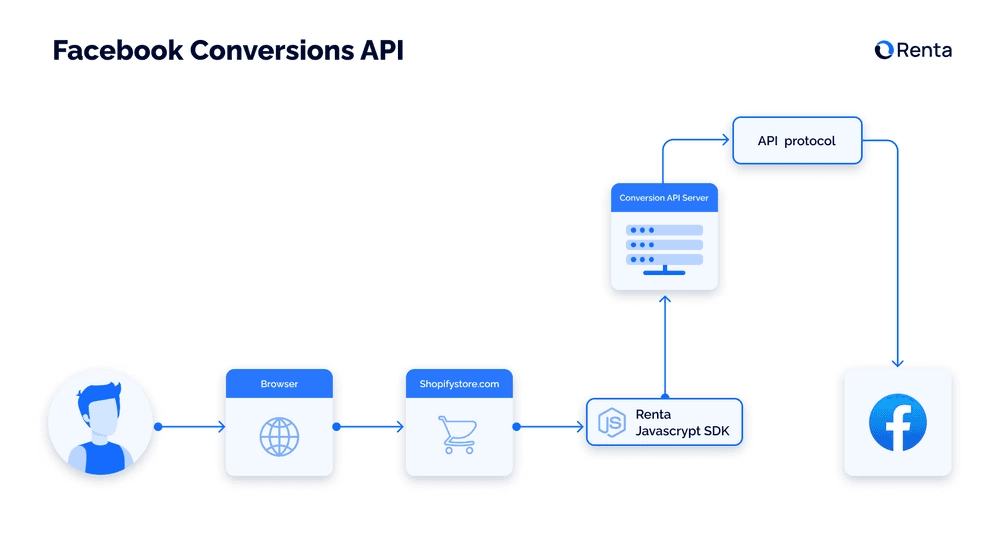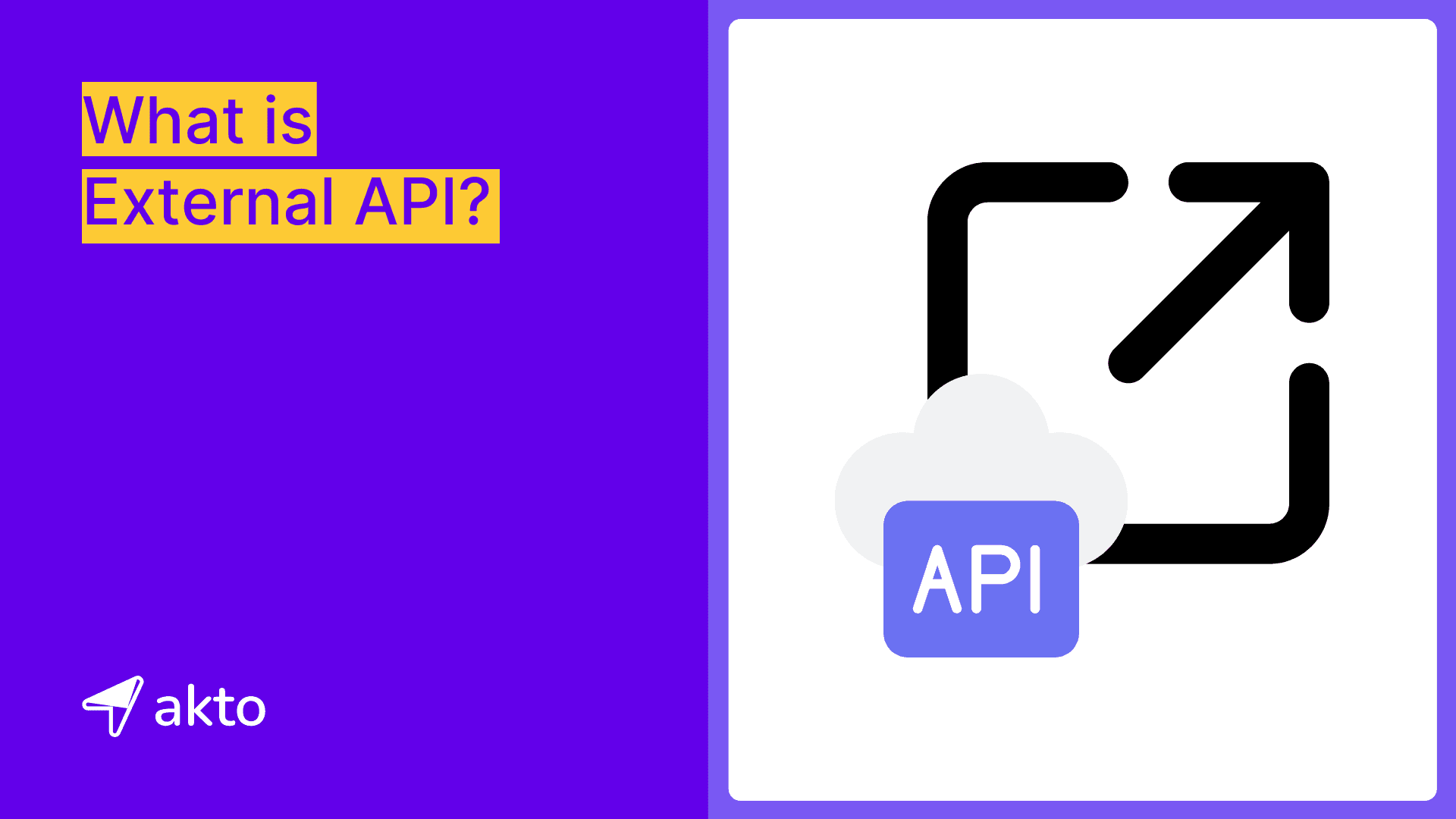What is External API?

Insha
Oct 10, 2024
An external API is an interface that enables one application to communicate with another over the internet. It allows developers and security engineers to access certain functionalities or data from an external application. This interaction helps integrate features from different systems into one application.
This blog explores external APIs, their uses, potential security risks, and methods to secure them to protect the organization’s data.
What is External API?
An external API allows one application to connect and share information with another over the internet. It acts as a bridge between different systems, enabling them to work together without needing to understand the internal workings of each other.
For example, a travel app might use an external API to access flight information from an airline’s system and display it in the app. This integration lets users view flight schedules, prices, and availability in real time without leaving the app. External APIs make it easier for developers to add features and services from other platforms, improving functionality and user experience.
How Does It Differ from Internal APIs?
Organizations use internal APIs only within their systems to connect them. For example, an internal API might link an organization's HR system to its payroll system, ensuring seamless data flow within the organization.
External APIs, however, connect systems from different organizations. This allows organizations to enhance its services by integrating third-party features. For example, an online store might use an external API to calculate shipping rates from various carriers.
Importance of External APIs
External APIs are important because they enable different applications to work together smoothly. By allowing one app to connect to another, external APIs help developers and security engineers add new features and services without building everything from scratch.
For example, an e-commerce website can use an external API to offer payment processing through a trusted service, improving both functionality and security. APIs also make it easier to share data between organization systems, saving time and resources.
How External APIs Work?
External APIs work by allowing two different systems or applications to communicate and share data over the Internet. When an app wants to access specific features or data from another platform, it sends a request to the external API.
The application makes this request using standard protocols like HTTP, and the API defines how the app can access the data and what it can do with it. The external API processes the request and sends back a response, which can be the requested data or confirmation of an action, such as processing a payment or fetching user information.
Developers use external APIs to integrate external functionalities into their applications without needing to build everything from scratch. For example, instead of creating their mapping service, a developer can use the Google Maps API to add map functionality to their app.
This makes development faster and more efficient and ensures the application benefits from the capabilities of trusted services. External APIs also standardize how different systems communicate, ensuring a smooth data exchange between them.
Security is a critical aspect of external APIs. Since APIs expose certain functionalities of an application to other apps, they must be secured to prevent unauthorized access. API keys, OAuth, and other authentication methods help ensure that only authorized users can interact with the API. Properly securing external APIs protects the service provider and the users, ensuring they keep sensitive data safe.
Examples of Popular External APIs
Let's explore some widely used external APIs that demonstrate the power and versatility of these interfaces:
Google Maps API

The Google Maps API allows apps and websites to display interactive maps, provide directions, and help users find specific places. By integrating this API, developers and security engineers can enhance their apps with real-time location data, enabling users to search for locations, plan routes, and explore areas directly within the app. Developers widely use this API in travel apps, delivery services, and any platform needing map functionality, offering users a seamless and familiar experience.
Twitter API
The Twitter API allows apps to interact directly with Twitter, enabling features like posting tweets, retrieving user information, and analyzing tweet data. Developers use this API to integrate Twitter functionality into their apps, letting users tweet or view timelines without leaving the app.
It also helps organizations analyze trends, track engagement, and gather insights from tweet data. By using the Twitter API, apps can create a more connected and engaging experience for users while accessing real-time information from Twitter’s vast platform.
Stripe API

The Stripe API enables websites and apps to securely process payments, manage subscriptions, and handle transactions. Developers and security engineers use this API to integrate payment functionality into their platforms, allowing users to make purchases or manage billing directly within the app.
With Stripe, businesses can accept various payment methods, automate recurring billing, and track transactions efficiently. The API ensures security and compliance, making it a trusted solution for handling online payments and financial operations seamlessly.
Weather API
The Weather API provides real-time weather data for various locations, allowing apps and websites to display current conditions, forecasts, and alerts. Developers and security engineers use this API to offer users up-to-date weather information, enhancing apps with features like live temperature updates, rain alerts, and extended forecasts. By integrating the Weather API, businesses and services can keep their users informed about changing weather patterns, helping them plan better for daily activities or travel.
Facebook API

The Facebook API allows apps to connect directly with Facebook, enabling features like logging in with Facebook, sharing content, and accessing user profiles and friend lists. Developers and security engineers use this API to integrate Facebook functionality into their apps, making it easier for users to sign in, interact, and share updates. It also allows apps to personalize user experiences by pulling data from Facebook profiles, such as interests or social connections, enhancing engagement and connectivity.
YouTube API
The YouTube API lets apps and websites access YouTube’s video content, upload videos, and retrieve video statistics. Developers and security engineers use this API to integrate YouTube features, allowing users to watch videos, manage playlists, and upload content directly from their apps.
It also provides access to valuable video data, like views, likes, and comments, helping businesses and creators track performance and engagement. By using the YouTube API, apps can offer a seamless video experience and leverage YouTube's vast content library.
Challenges and Solutions in External APIs
Organizations face some challenges while implementing external APIs. These challenges can range from understanding the documentation to handling errors and unexpected responses. However, with a structured approach, organizations can effectively tackle them.
Handling API Changes and Versioning
APIs evolve, and preparing for updates and deprecations is essential. When an API provider introduces new features or improvements, they may also remove outdated functionalities. To manage these changes, stay informed by regularly checking the API provider’s documentation and announcements. Planning the updates is key—when an API changes, ensure security teams update the application accordingly and thoroughly test these updates to prevent disruptions.
Implementing versioning strategies is a smart way to handle changes. Versioning allows organizations to create a new version of the API whenever updates are made, without affecting users still relying on the older version.
This ensures a smooth transition while maintaining backward compatibility. Clear documentation of each version is crucial, as it helps users understand what has changed and how to adapt to new features or updates.
Dependency Management
Relying on third-party APIs introduces certain risks, such as API changes, downtimes, or even the discontinuation of the service. These disruptions can affect the application's performance and impact user experience. To mitigate these risks, it's important to diversify the dependencies. Avoid relying on a single API for critical functions, and consider having backups or alternative APIs in place.
Monitoring the APIs that applications depend on is another essential strategy. Set up alerts to notify security teams of any changes, issues, or downtimes. Additionally, developers should design the code with flexibility in mind so that security teams can easily switch to a different API if necessary, reducing the impact of potential disruptions on the application.
Performance Optimization
Reducing latency is crucial for optimizing the application's performance. Latency, the delay before data transfer begins, can slow down the application if not properly managed. To minimize latency, choose APIs that are geographically closer to the users and consider using a content delivery network (CDN) to speed up data transfers.
Caching strategies also play a significant role in improving performance. Caching involves storing frequently accessed data temporarily to reduce the need for repeated API calls. For example, security teams can cache user profile data that doesn’t change often, reducing the load on the API. Implement cache expiration strategies to ensure that cached data remains up-to-date, setting time limits for how long data is stored before refreshing it.
Handling Rate Limits
External APIs often impose rate limits, restricting the number of requests the application can make within a given time frame. Exceeding these limits can result in the application denying requests, affecting its functionality.
To overcome this, implement request throttling and queueing mechanisms to ensure the application stays within the allowed limits. Additionally, monitor the API usage regularly and optimize requests by using techniques like batch processing and caching to minimize unnecessary calls.
Ensuring API Security
Security is a significant concern when using external APIs, as data exchanged between applications can be vulnerable to attacks. To address this challenge, always use secure communication protocols like HTTPS and ensure that security teams authenticate all API requests using methods such as API keys, OAuth, or tokens.
Additionally, implement proper access controls to limit the data and actions available to users, and regularly audit the API integrations for potential vulnerabilities to maintain security.
Best Practices for Using External APIs
Let's take a closer look at some of the best practices security engineers can implement for working with external APIs in their organization. Whether developers and security engineers are developing a new application or enhancing an existing one, these practices will help them make the most of the external APIs the applications rely on.
Security Considerations
Ensuring secure connections is crucial when using external APIs. Always use HTTPS to encrypt data exchanged between the application and the API. This protects sensitive information and prevents attackers from intercepting it.
Sensitive data, like API keys, should never be exposed in the application’s code. Store them securely and access them through secure methods. Additionally, encrypt user credentials and personal data, both in transit and at rest, to ensure their safety.
To handle vulnerabilities, keep the software and dependencies up to date by applying patches for known issues. Regularly conduct security audits and use tools to scan for potential weaknesses in the API integration.
Documentation and Testing
Comprehensive documentation is essential for making external APIs user-friendly and effective. Provide clear and detailed documentation, including examples, endpoint explanations, and request/response formats.
This helps developers use the API properly and avoid errors. Tools like Swagger and Postman make it easy to create interactive documentation, allowing developers to test API endpoints directly from the docs.
Testing is equally important before integrating an API into the application. Thoroughly test the API to identify potential issues early on, including functionality, performance, and security checks. Automated testing tools can simplify the process and ensure the API works as expected without causing problems in the application.
Monitoring and Analytics
Monitoring API usage is key to understanding how and when the API is being accessed. Set up logging and monitoring systems to track usage patterns and detect any unusual or unauthorized activities. Keeping a close eye on API usage helps prevent security breaches and ensure proper functionality.
Analyzing API performance is another important step. Regularly review the API's response times, error rates, and overall performance to ensure it meets the application’s needs. Use analytics tools to track metrics and identify areas that need optimization so security teams can address issues before they impact users.
Limit API Requests
Control the number of requests the application sends to an external API to avoid overloading the service and exceeding rate limits. APIs often have strict limits on how many requests they can handle within a certain timeframe.
If the application exceeds these limits, it could block access or degrade performance. To prevent this, implement caching to store frequently accessed data locally, reducing the need for repetitive API calls.
Developers and security engineers can also batch requests when possible, sending multiple queries at once rather than individually. This reduces the load on the API and increases the efficiency of the application. Rate limiting ensures a smoother experience for both the users and the API provider, avoiding unnecessary delays or interruptions.
Use Authentication and Authorization
Always authenticate the API requests using secure methods like API keys, OAuth, or tokens. These authentication methods verify the identity of the requesting app and ensure that only authorized users and applications can access the API’s resources.
This process helps prevent malicious activities, such as unauthorized data access or API misuse. Implement role-based access controls to further enhance security by limiting what certain users can access or modify within the API.
Regularly update and rotate the API keys or tokens to protect against compromised credentials. Security engineers must implement Secure authentication and authorization practices to safeguard both the application and the external service from breaches or data leaks.
Final Thoughts
External APIs are essential interfaces that enable different software systems to interact and share data seamlessly. They provide significant advantages, such as access to external resources and improved efficiency.
However, they also present challenges, particularly around security and reliance on third-party services. To safeguard the data and maintain smooth operations, it's crucial to manage and monitor API usage closely.
Akto helps organizations identify vulnerabilities in external APIs. Akto automates API security testing, offering real-time monitoring and automated checks to effectively detect and mitigate risks. By booking a demo, organizations can explore how Akto’s solutions enhance their API security and strengthen their overall security posture.
Explore more from Akto
Blog
Be updated about everything related to API Security, new API vulnerabilities, industry news and product updates.
Events
Browse and register for upcoming sessions or catch up on what you missed with exclusive recordings
CVE Database
Find out everything about latest API CVE in popular products
Test Library
Discover and find tests from Akto's 100+ API Security test library. Choose your template or add a new template to start your API Security testing.
Documentation
Check out Akto's product documentation for all information related to features and how to use them.

